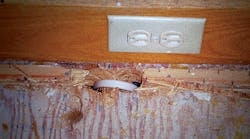A Secret Passageway
Some concerned carpet installers asked me to take a look at what they uncovered when they were replacing the carpet in this home. It appears as though the installer, who was trying to snake this NM cable to feed the receptacle, was having difficulty getting by one of the joists, so he decided to notch the subfloor and go up and over the joist. I assume he pulled back the carpet to make the notches, and then placed the carpet back down once he completed the installation. Unfortunately, this left the cable precariously positioned without any protection.
Section 300.4(A)(2) has specific requirements where cables or raceways are installed in notches made in wood members. Where the notches will not cause any weakening of the building structure, cables or raceways shall be permitted to be laid in notches made in studs, joists, rafters, or other wood members in either concealed or exposed locations. The cable or raceway installed in those notches must be protected against damage from nails or screws by a steel plate at least 1⁄16 in. thick. The steel plate must be an appropriate length and width, installed to cover and protect the wiring. The steel plate must be installed before the building finish is applied.
A Mixed and Matched Mess
According to Sec. 406.3(C), 15A- and 20A-rated receptacles designed for the direct connection of aluminum conductors must be marked CO/ALR. No such markings were found on this receptacle; therefore, it was not rated for aluminum conductors. According to Sec. 110.14, conductors of dissimilar metals such as copper and aluminum must not be intermixed in a terminal or splicing connector where physical contact occurs between the dissimilar metals unless the device is identified for the purpose. This receptacle was not. Also, Sec. 110.14(A) requires terminals for connection of more than one conductor to be identified for that purpose. This receptacle was not designed for that purpose either.
According to Sec. 250.24(A)(5), a grounded conductor must not be connected to an equipment grounding conductor or be reconnected to ground on the load side of the service disconnecting means except as otherwise permitted in Art. 250. According to Sec. 250.142(B), a grounded conductor must not be used for grounding of metal, non-current-carrying parts of equipment on the load side of a service disconnect or a separately derived system. Art. 250 contains no wording that permits the equipment grounding conductor to be connected to the receptacle neutral in this manner.






